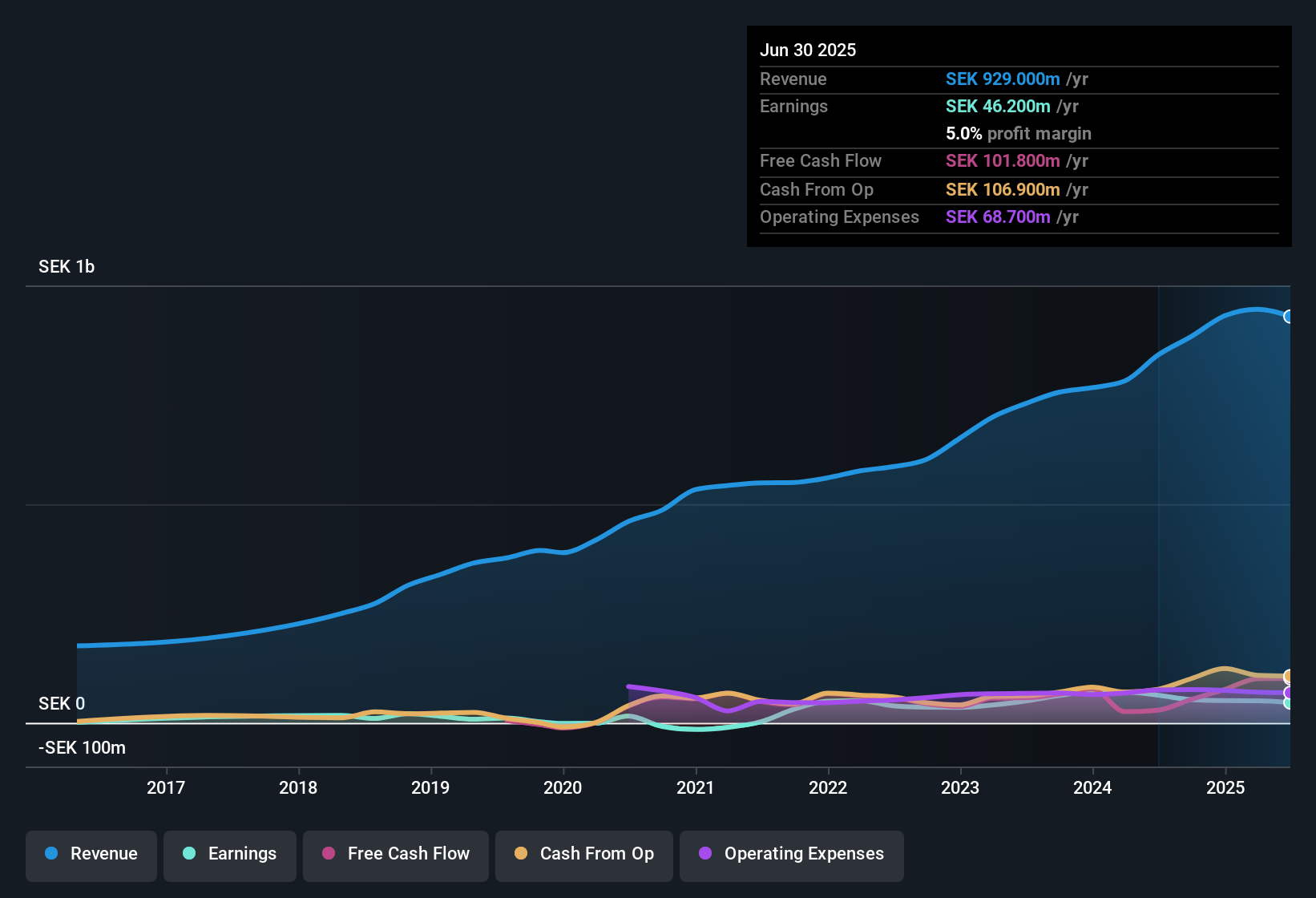CombinedX's (STO:CX) Conservative Accounting Might Explain Soft Earnings
CombinedX AB (publ)'s (STO:CX) earnings announcement last week didn't impress shareholders. Despite the soft profit numbers, our analysis has optimistic about the overall quality of the income statement.

A Closer Look At CombinedX's Earnings
One key financial ratio used to measure how well a company converts its profit to free cash flow (FCF) is the accrual ratio. The accrual ratio subtracts the FCF from the profit for a given period, and divides the result by the average operating assets of the company over that time. The ratio shows us how much a company's profit exceeds its FCF.
That means a negative accrual ratio is a good thing, because it shows that the company is bringing in more free cash flow than its profit would suggest. That is not intended to imply we should worry about a positive accrual ratio, but it's worth noting where the accrual ratio is rather high. That's because some academic studies have suggested that high accruals ratios tend to lead to lower profit or less profit growth.
For the year to June 2025, CombinedX had an accrual ratio of -0.12. That indicates that its free cash flow was a fair bit more than its statutory profit. Indeed, in the last twelve months it reported free cash flow of kr102m, well over the kr46.2m it reported in profit. CombinedX shareholders are no doubt pleased that free cash flow improved over the last twelve months. Unfortunately for shareholders, the company has also been issuing new shares, diluting their share of future earnings.
That might leave you wondering what analysts are forecasting in terms of future profitability. Luckily, you can click here to see an interactive graph depicting future profitability, based on their estimates.
One essential aspect of assessing earnings quality is to look at how much a company is diluting shareholders. As it happens, CombinedX issued 6.0% more new shares over the last year. That means its earnings are split among a greater number of shares. To celebrate net income while ignoring dilution is like rejoicing because you have a single slice of a larger pizza, but ignoring the fact that the pizza is now cut into many more slices. You can see a chart of CombinedX's EPS by clicking here.
A Look At The Impact Of CombinedX's Dilution On Its Earnings Per Share (EPS)
As you can see above, CombinedX has been growing its net income over the last few years, with an annualized gain of 19% over three years. In contrast, earnings per share were actually down by 3.4% per year, in the exact same period. Net profit actually dropped by 27% in the last year. Unfortunately for shareholders, though, the earnings per share result was even worse, declining 32%. And so, you can see quite clearly that dilution is influencing shareholder earnings.
In the long term, if CombinedX's earnings per share can increase, then the share price should too. But on the other hand, we'd be far less excited to learn profit (but not EPS) was improving. For the ordinary retail shareholder, EPS is a great measure to check your hypothetical "share" of the company's profit.
Our Take On CombinedX's Profit Performance
In conclusion, CombinedX has a strong cashflow relative to earnings, which indicates good quality earnings, but the dilution means its earnings per share are dropping faster than its profit. After taking into account all these factors, we think that CombinedX's statutory results are a decent reflection of its underlying earnings power. If you want to do dive deeper into CombinedX, you'd also look into what risks it is currently facing. You'd be interested to know, that we found 3 warning signs for CombinedX and you'll want to know about them.
In this article we've looked at a number of factors that can impair the utility of profit numbers, as a guide to a business. But there are plenty of other ways to inform your opinion of a company. Some people consider a high return on equity to be a good sign of a quality business. So you may wish to see this free collection of companies boasting high return on equity, or this list of stocks with high insider ownership.
New: AI Stock Screener & Alerts
Our new AI Stock Screener scans the market every day to uncover opportunities.
• Dividend Powerhouses (3%+ Yield)
• Undervalued Small Caps with Insider Buying
• High growth Tech and AI Companies
Or build your own from over 50 metrics.
Have feedback on this article? Concerned about the content? Get in touch with us directly. Alternatively, email editorial-team (at) simplywallst.com.
This article by Simply Wall St is general in nature. We provide commentary based on historical data and analyst forecasts only using an unbiased methodology and our articles are not intended to be financial advice. It does not constitute a recommendation to buy or sell any stock, and does not take account of your objectives, or your financial situation. We aim to bring you long-term focused analysis driven by fundamental data. Note that our analysis may not factor in the latest price-sensitive company announcements or qualitative material. Simply Wall St has no position in any stocks mentioned.
About OM:CX
Flawless balance sheet with reasonable growth potential and pays a dividend.
Market Insights
Community Narratives



